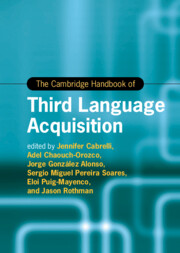Book contents
- The Cambridge Handbook of Third Language Acquisition
- Cambridge Handbooks in Language and Linguistics
- The Cambridge Handbook of Third Language Acquisition
- Copyright page
- Contents
- Figures
- Tables
- Contributors
- Introduction Multilingualism
- Part I Theoretical Approaches to L3/Ln
- Part II L3/Ln across Linguistic Domains
- 5 Exploring the Acquisition of L3 Phonology
- 6 Characteristics of the L3 Lexicon
- 7 Processing Words in a Multilingual Lexicon
- 8 Full Transfer in L3/Ln Acquisition
- 9 Full Transfer Potential in L3/Ln Acquisition
- 10 The Acquisition and Processing of Pragmatics in Multilinguals and Third Language Learners
- Part III Becoming and Staying Multilingual at Different Ages
- Part IV L3/Ln in Action
- Part V L3/Ln and Cognition
- Part VI Research Methods in L3/Ln
- Index
- References
10 - The Acquisition and Processing of Pragmatics in Multilinguals and Third Language Learners
from Part II - L3/Ln across Linguistic Domains
Published online by Cambridge University Press: 13 July 2023
- The Cambridge Handbook of Third Language Acquisition
- Cambridge Handbooks in Language and Linguistics
- The Cambridge Handbook of Third Language Acquisition
- Copyright page
- Contents
- Figures
- Tables
- Contributors
- Introduction Multilingualism
- Part I Theoretical Approaches to L3/Ln
- Part II L3/Ln across Linguistic Domains
- 5 Exploring the Acquisition of L3 Phonology
- 6 Characteristics of the L3 Lexicon
- 7 Processing Words in a Multilingual Lexicon
- 8 Full Transfer in L3/Ln Acquisition
- 9 Full Transfer Potential in L3/Ln Acquisition
- 10 The Acquisition and Processing of Pragmatics in Multilinguals and Third Language Learners
- Part III Becoming and Staying Multilingual at Different Ages
- Part IV L3/Ln in Action
- Part V L3/Ln and Cognition
- Part VI Research Methods in L3/Ln
- Index
- References
Summary
We review studies that investigated pragmatic acquisition and processing in multilingual children and adults, and third language (L3) learners. Studies on pragmatic differentiation in simultaneous multilingual children show that they can differentially and appropriately use their languages in a context-sensitive manner from the age of two. The evidence on implicature reveals that multilinguals exhibit interpretation skills comparable to monolinguals; and that degree of multilingualism, measured continuously, has a positive effect. Research that examined speech acts from the perspective of crosslinguistic influence has provided some evidence (though mixed and unclear) that the L1 can affect L2 and L3 speech act performance. This influence can also occur from the L3 to the L1 and L2 in young children. Moreover, work on speech acts has shown that bilinguals, and especially balanced bilinguals, enjoy an advantage in learning the pragmatics of an additional language. We close the chapter by suggesting directions for future work.
- Type
- Chapter
- Information
- The Cambridge Handbook of Third Language Acquisition , pp. 243 - 268Publisher: Cambridge University PressPrint publication year: 2023
References
- 1
- Cited by



